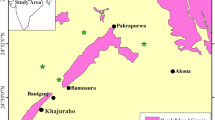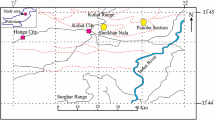Abstract
Climate and geological conditions are among main the factors that can affect the erosion and natural dissolution of rocks. In the present study, we investigate the solubility variation of 144 rock samples taken from different depths of Tirgan limestone formation (Kopet-Dagh Mountains) under various pH (CO2 injection) and temperature conditions during 2880 h of testing. For all of samples microscopic sections were prepared and studied. Furthermore, the porosity and dry unit weight of all samples were measured and some of them were analyzed by scanning electron microscope (SEM) and X-ray diffraction (XRD and XRF). The results show that the effect of temperature variations on the dissolution of the calcite limestone samples is higher than dolomite samples. Moreover, the dry unit weight of micrite samples shows a smaller drop after the dissolution test. The variation of dissolution level in grain-stone type samples was wider, due to a decrease in pH of water. According to this study, the effect of temperature is much less than the increase in the percentage of atmospheric carbon dioxide on the amount of limestone dissolution. Moreover, a sudden increase is noticed in the dissolution of samples with a porosity higher than 3.45%. Considering the geological characteristics of the limestone formation of Tirgan and the results of the experiments, it can be concluded that at the depth ranges of 40–55 m and 145–175 m provide more suitable conditions for the formation of advanced karst systems.







Similar content being viewed by others
References
Alavi M, Vaziri H, Seyed-Emami K, Lasemi Y (1997) The triassic and associated rocks of the Aghdarband areas in Central and North Eastern Iran as remnants of the Southern Turanian active continental margin. Geol Soc Am Bull 109(12):1563–1575
Arvidson RS, Ertan I, Amonette JE, Sluttge A (2003) Variation in calcite dissolution rates: a fundamental problem? Geochim Cosmochim Acta 67(9):1623–1634
Aryaei A, Torshizian H, Taherpourkhalilabad M (2014) Analyzing and revision of the Southern limb of Radkan-Baru syncline and presentation of morphotectonic evidences from the Hezar-masjedmountains to Bajgiran and unseens from the tectonostratigraphic points view (Central and West of Kopet-dagh). Iran. In: Mashhad. 32nd National and the 1st International Geosciences Congrees, pp 641–647
Berberian M, King GCP (1981) Toward a paleogeography and tectonic evolution of Iran. Can J Earth Sci 18(2):210–265
Berrezueta E, Kovacs T, Luquot L (2017) Qualitative and quantitative changes of carbonate rocks exposed to SC CO2 (Basque-Cantabrian Basin, Northern Spain). Appl Sci 7(11):1124
Buryakovsky L, Aminzadeh F, Chilingarian GV (2001) Petroleum geology of the South Caspian Basin. Gulf Professional Publishing, USA, p 422
Clemens T, Huckinghaus D, Liedl R, Sauter M (1999) Simulation of the development of karst aquifers: role of the epikarst. Int J Earth Sci 88(1):157–162
Dunham RJ (1964) Classification of carbonate rocks according to depositional textuire. In: Ham WE (ed) Classification of carbonate rocks-a symposium. American Association of Petroleum Geologists Memoir 1: 108–121
Fischer C, Arvidson RS, Lüttge A (2012) Howpredictable are dissolution rates of crystalline material? Geochim Cosmochim Acta 98:177–185
Folk RL (1980) Petrology of sedimentary rocks. Hemphill Publishing Co. Austin, Texas, p 182
Grasso DA, Jeannin PY, Zwahen F (2003) A deterministic approach to the coupled analysis of karst springs’ hydrographs and chemographs. J Hydrol 271(1–4):65–76
He Z, Ding Q, Wo Y, Zhang J, Fan M, Yue X (2017) Experiment of carbonate dissolution: implication for high quality carbonate reservoir formation in deep and ultradeep Basins. Geofluids 2:1–8
Kaufmann G, Dreybrodt W (2007) Calcite dissolution kinetics in the system CaCO3–H2O–CO2 at high undersaturation. Geochimica et Cosmocnimica Acta 71:1398–1410
Kump LR, Brantley SL, Arthur MA (2000) Chemical weathering, atmospheric CO2 and climate. Earth Planet 28:611–667
Liu Z, Yuan D, Dreybrodt W (2005) Comparative study of dissolution rate-determining mechanisms of limestone and dolomite. Environ Geol 49:274–279
Liu Q, Lu Y, Zhang F (2013) Laboratory simulation experiment on dissolution of limestone under hydrodynamic pressure. Carbonates Evaporites 28:3–11
Liu LH, Ma YS, Liu B, Wang CL (2016) Hydrothermal dissolution of Ordovician carbonates rocks and its dissolution mechanism in Tarim Basin, China. Carbonates Evaporites 32:525–537
Martinez L, Luquot L, Carrera J (2017) Changes in hydrodynamic, structural and geochemical properties in carbonate rock amples due to reactive transport. Procedia Earth Planet 17:885–888
Muro HG, Sohrabi M, Benavente D (2017) Dissolution of the rock during smart water injection in heavy oil carbonate reservoirs by natural generation of acidic water. Energy Fuels 31(11):11852–11865
Taheri M, Nikudel MR, Khamehchiyan M, Taheri K (2016) Laboratory simulation of karst development in carbonate rocks containing nsoluble substances: a case study from west Iran. Bull Eng Geol Environ 75:53–62
Zhang C, Shu L, Adjei EKA, Lobeyo AGA, Tang R, Fan J (2015) Laboratory simulation of groundwater hydraulic head in a karst aquifer system with conduit and fracture domains. Carbonates Evaporites 31:329–337
Author information
Authors and Affiliations
Corresponding author
Additional information
Publisher's Note
Springer Nature remains neutral with regard to jurisdictional claims in published maps and institutional affiliations.
Rights and permissions
About this article
Cite this article
Mousavi Maddah, S.M., Hafezi Moghaddas, N. & Ghafoori, M. Solubility variations of Tirgan limestone in Northeast of Iran with change of PH and temperature. Carbonates Evaporites 35, 9 (2020). https://doi.org/10.1007/s13146-019-00539-7
Accepted:
Published:
DOI: https://doi.org/10.1007/s13146-019-00539-7




